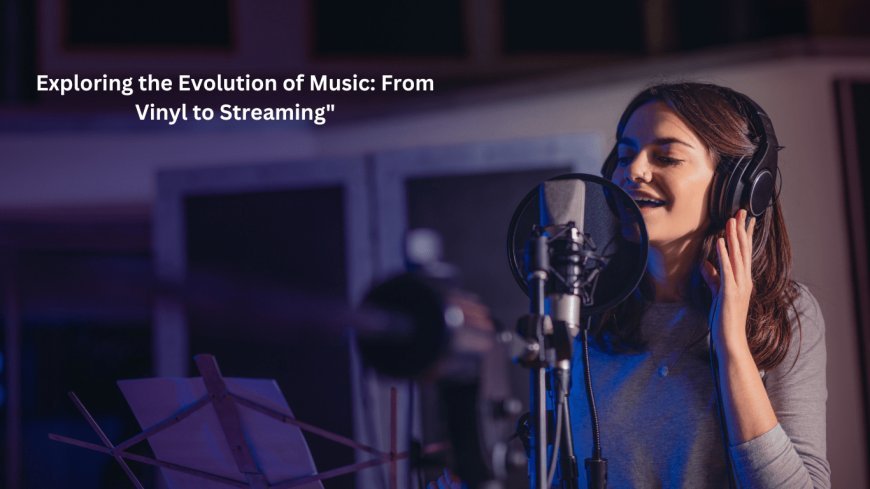Exploring the Evolution of Music: From Vinyl to Streaming – A Journey Through Sound
Discover how music has evolved over the decades, from the analog warmth of vinyl to the digital convenience of streaming. Explore the milestones that transformed the music industry.

Blog Summary:
This blog post covers music consumption from vinyl to CDs to streaming. We'll study how each format affected music, business, and artist-fan connection. History, technology, and culture will be covered in this essay. Expect to learn about music format pioneers and consumption patterns.
Exploring the Evolution of Music: From Vinyl to Streaming
Music has always been part of human society, but listening has altered tremendously. From vinyl records' crackling warmth to digital streaming's simplicity and immediacy, the music industry has altered tremendously. Our connection with music, artists, and the world has changed as technology has. Let's examine how vinyl and streaming have changed our lives.
The Golden Age of Vinyl: The Sound of Nostalgia
Return to the beginning. Through the late 1980s, vinyl records, the "analog king," dominated music. The vinyl record made music tangible. The album artwork, flipping the record, and analog sound's delightful crackles enhanced music listening.
The Vinyl Boom
As recordings supplanted shellac records, vinyl became popular in the late 1940s and 1950s. Vinyl records were perfect for broad use due to their better sound and durability. Album culture affected the music industry throughout the 1960s and 1970s. LPs let artists explore with their sound on a broader scale.
Although radios and pop culture took off, vinyl records remained popular. Pops and hisses from a favorite vinyl record are hard to surpass.
The Decline: Enter the CD
In the late 1980s, CDs replaced vinyl as the main music medium. The CD was smaller, stronger, and promised superior sound without vinyl problems.
The Rise of CDs: Convenience Meets Quality
The compact disc made listening to favorites easier for music listeners. CD sound was clearer and didn't degrade like vinyl. Changing from vinyl to CD was revolutionary. No more flipping records mid-song or worrying about blemishes on your favorite LP.
CD’s Dominance in the 90s and Early 2000s
CD sales peaked in 1990s. The audio quality was unmatched and albums could be transported in a small compact. Moving from vinyl to CDs altered music listening. Digital CD covers and jewel boxes replaced album art and vinyl records, although many preferred the enhanced listening experience.
The Digital Age: MP3s and Piracy
Internet expansion and digital downloading led to MP3s in the early 2000s. Compressing music makes it easier to share online or save on devices. Napster revolutionized music delivery, making "piracy" a problem.
While convenient, easy to store, and quick to share, MP3s have problems. The music industry struggled to control distribution as more people utilized file-sharing websites and digital downloads. Quick, button-press audio access was permanent.
Streaming: The Digital Revolution
Time to stream. Late 2000s streaming services Pandora, Spotify, and Apple Music ruled the internet. Users may stream millions of music without buying or storing. This major modification simplified music listening and artist discovery. Without downloading or waiting for CDs—instant access.
The Convenience of Streaming
Streaming is easier than ever. Listening to your favorite songs no longer needs a CD collection or messy MP3 library. Members may access millions of songs. Streaming allowed musicians to reach global audiences.
The rise of streaming has changed music values. The economic model evolved as unlimited music became widespread. Subscription-based streaming platforms make music accessible, but artists complain about low remuneration. Despite challenges, the model remains popular.
The Future of Music Streaming
Overtaking CDs and digital downloads, streaming dominates music consumption. AI and customized recommendation algorithms power streaming services, the future of music. Who knows how VR and spatial audio will affect music consumption in the next decade?
The Impact of the Evolution on Music Culture
Each format change affects music culture. Vinyl records connected artists and audiences. Physical records were art, not just music. Gatefolds, album art, and flipping records mattered.
Though more convenient, CDs make music disposable. The physical aspect of music became less important as convenience replaced tactile involvement.
Music culture is accessible via streaming. Music listening now emphasizes discovery over ownership. Music discovery is digital and personalized thanks to playlists, streaming algorithms, and curation.
Conclusion: From Vinyl to Streaming—A Full Circle?
Music format evolution: what's learned? Over the last century, the music industry has transformed. Vinyl records' warmth and streaming's convenience have transformed music listening.
Vinyl still appeals to audiophiles and collectors, but streaming may win. The expanded access, options, and ways to enjoy music captivate fans. Who knows what follows? Vinyl may return or change formats. No doubt, music will develop.
FAQs
1. Why is vinyl considered better than digital formats?
Music aficionados say vinyl records sound warmer and more genuine than digital ones. Vinyl's crackle and pop may be nostalgic or pleasurable.
2. Will streaming ever replace physical music entirely?
Vinyl and CD remain popular despite streaming. Most listeners prefer streaming, but tactile and collectible forms will certainly never go off.
3. How has music consumption changed in the last decade?
In the past decade, streaming has overtaken digital downloads and physical media as the major music format. With Apple Music and Spotify, streaming millions of music is easier than ever.

 Najmul Hasan
Najmul Hasan 





